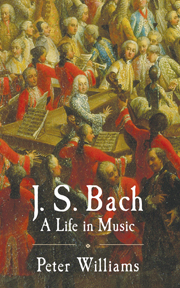Book contents
- Frontmatter
- Contents
- Preface
- Acknowledgments
- Map of Northern Germany in the time of J. S. Bach
- Map of Thuringia and Saxony in the time of J. S. Bach
- 1 Early years 1685–1703
- 2 First appointments 1703–8
- 3 Weimar 1708–17
- 4 Cöthen 1717–23
- 5 Leipzig, the first years
- 6 Leipzig, the middle years
- 7 Leipzig, the final years
- 8 Observations, descriptions, criticisms
- Epilogue
- Postscript
- Glossary
- List of references
- Index of works (BWV)
- Index of names
6 - Leipzig, the middle years
Published online by Cambridge University Press: 10 December 2009
- Frontmatter
- Contents
- Preface
- Acknowledgments
- Map of Northern Germany in the time of J. S. Bach
- Map of Thuringia and Saxony in the time of J. S. Bach
- 1 Early years 1685–1703
- 2 First appointments 1703–8
- 3 Weimar 1708–17
- 4 Cöthen 1717–23
- 5 Leipzig, the first years
- 6 Leipzig, the middle years
- 7 Leipzig, the final years
- 8 Observations, descriptions, criticisms
- Epilogue
- Postscript
- Glossary
- List of references
- Index of works (BWV)
- Index of names
Summary
THE COLLEGIUM MUSICUM AND CHAMBER REPERTORIES
How soon after taking on increased duties with the Collegium in March 1729 Bach worked on his concertos and other music for mixed ensembles, and then performed them in the Collegium concerts, is not clear. One imagines very soon: he certainly made copies about then of suitable pieces from elsewhere, such as full-length instrumental ouvertures (suites) by Johann Bernhard Bach of Eisenach, successor to the admired Christoph (†1703). Just as unclear is whether there is any direct link between Collegium activities and an apparent falling-off in church cantatas. Composing up-to-date music for outside the church need not have dampened creativity within it: organ music (church music of a kind) was still being worked on, and to a surprising extent the different genres remain independent of each other, both in musical style and in the attention given them.
Whatever the Collegium commitment, particularly while Bach was director in 1729–37 and again on and off from 1739, it must have been pressing, very willingly undertaken, no doubt, since by now the cantata repertory was rich enough to satisfy any church's requirement. The Collegium met regularly each week, more often during the Spring and Autumn fairs, and the programmes gave all the opportunity that was desired to try over or repeat the various secular cantatas, especially those with big forces like BWV 205.
- Type
- Chapter
- Information
- J. S. BachA Life in Music, pp. 206 - 244Publisher: Cambridge University PressPrint publication year: 2007



